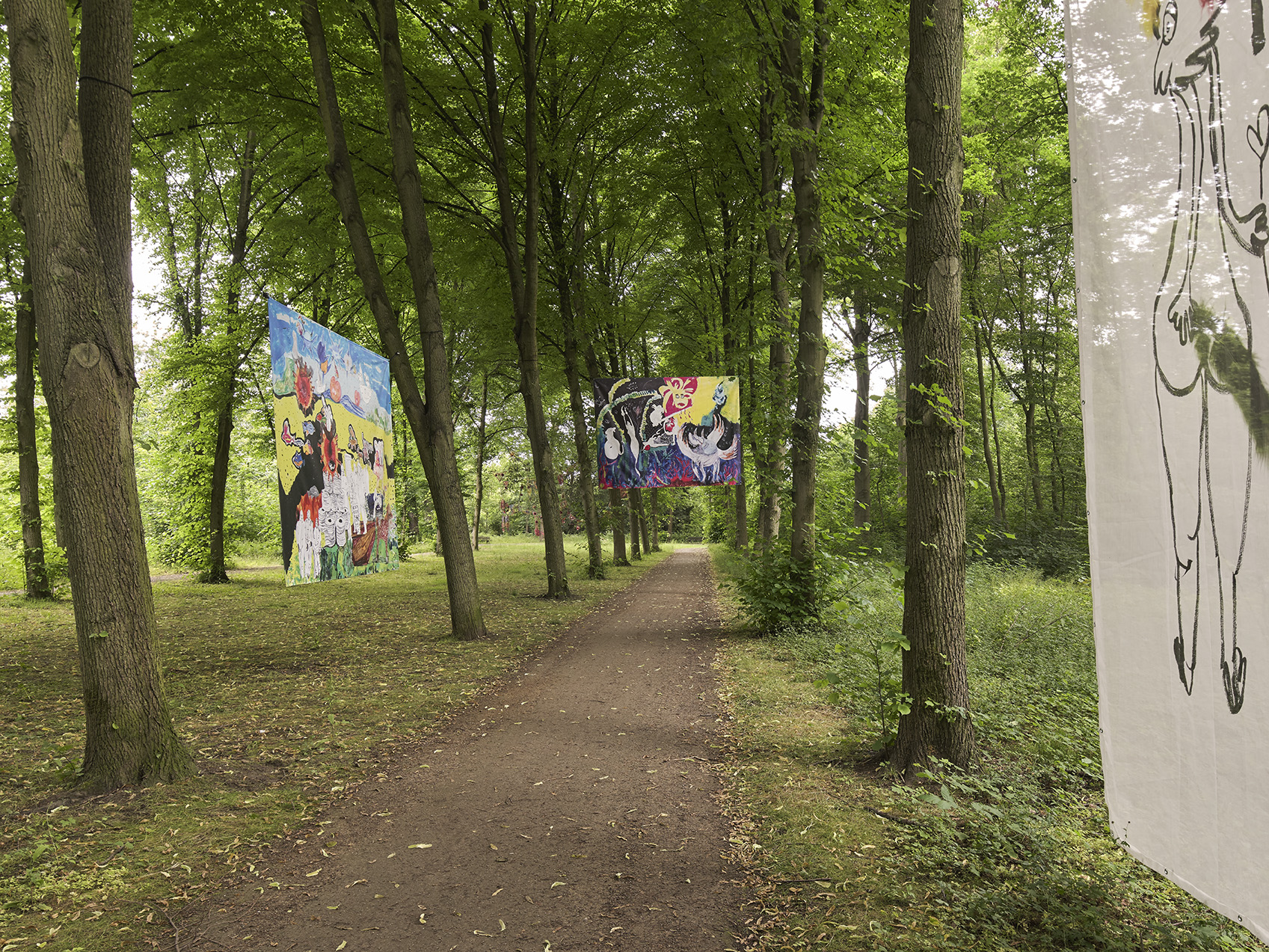Anne Duk Hee Jordan
Es ist Zeit, dass es Zeit wird, es ist Zeit, 2020
Blockout-Banner, UV-Druck, Pigment, Acryl
263 x 350 cm
From the deep sea archive – ‘Story of corals’ 2020
Blockout-Banner, UV-Druck, Pigment, Acryl
263 x 350 cm
Nur der früh gevögelte, vögelt früh genug, 2020
Federn, Marker, PVC-Plane
500 x 450 cm
Scroll down for the English version
Anne Duk Hee Jordan (*1978, Korea, lebt in Berlin) greift in ihren bewegten Skulpturen, Installationen, Zeichnungen und Videoarbeiten biologische und chemische Prozesse auf. Dabei erfasst sie die Erde als Ökosystem, mit dem sich der Mensch als inhärenter Teil kooperativ verbinden muss. Die Künstlerin selbst beschreibt ihre Arbeiten als „humorvolle, romantische Maschinen, die Transformationsprozesse sichtbar machen und die Grenzen zwischen unterschiedlichen Lebewesen in Frage stellen“.
Im Lantz’schen Park werden drei große, auf Bannern gedruckte Zeichnungen gezeigt. Sie veranschaulichen nicht nur die Vernetzung unterschiedlicher Situationen, sondern auch die Problematik heteronormativer Haltungen und die Verletzlichkeit des Einzelnen. „Es ist Zeit, dass es Zeit wird, es ist Zeit“ (2020) entstand zu Beginn der Corona-Pandemie. Der Titel der Arbeit bezieht sich auf ein Gedicht von Paul Celan. Der Bund zweier Liebenden wird in dem Gedicht in den Lauf der Gezeiten gesetzt, ein Fluss, in dem „der Stein sich zu blühen bequemt“ und im Traum geschlafen wird. In ihrer Zeichnung verbindet Anne Duk Hee Jordan vertraute Motive, wie die langen Warteschlagen für Klopapierrollen und ein Virus in Kugelform, mit historischen Motiven von Heiligen, die auf Schweinen reiten, und Hintern, die das Meer verunreinigen.
In ihrer Zeichnung „From the deep sea archive – ‘Story of corals’” aus demselben Jahr richtet die Künstlerin den Blick unter die Wasseroberfläche. Chimäre Wesen und müde Ritter verweilen hier, unter ihnen rot leuchtende Korallen, die an Höllenflammen auf Gemälden der alten Meister erinnern, über ihnen drohend der sonnig leuchtende Kopf der Medusa.
[1] Paul Celan, Corona, 2020
Anne Duk Hee Jordan addresses biological and chemical processes in her kinetic sculptures, installations, drawings, and video works. She regards the Earth as an ecosystem with which humans, an integral part of this system, must interact. She describes her works as “humorous, romantic machines that reveal transformation processes and question the boundaries between different living things.”
Three large drawings printed on banners are on display in Lantz’scher Park. They illustrate the interconnectedness of different situations, as well as the problematic nature of heteronormative attitudes and the vulnerability of the individual. “Es ist Zeit, dass es Zeit wird, es ist Zeit” (“It’s time that it’s time, it’s time”; 2020) was produced at the beginning of the coronavirus pandemic. The title is taken from a poem by Paul Celan, in which the vow between two lovers is set in the motion of the tide, a river in which “the stone deigns to bloom,” [1] and sleep takes place in dreams. In her drawing, Anne Duk Hee Jordan combines familiar motifs, such as the long queues for toilet paper and spherical viruses, with historical motifs of saints riding pigs and butts littering the sea.
In her drawing “From the deep sea archive – ‘Story of corals’” from the same year, the artist gazes below the surface of the water. We see chimeric creatures and weary knights, with glowing red corals beneath them, reminiscent of the flames of hell depicted by the Old Master paintings, and above them the glowing head of Medusa staring down threateningly.
Anne Duk Hee Jordan (born in Korea in 1978, lives in Berlin) studied at Berlin-Weissensee Art Academy and continued her studies with a master’s degree in fine arts under Olafur Eliasson at the Institute for Spatial Experiments in Berlin. In recent years, her work has been exhibited at Kunsthaus Hamburg and Martin Gropius Bau in Berlin (both in 2020), and Kunstverein Arnsberg (2019).
[1] Paul Celan, Corona, 2020


